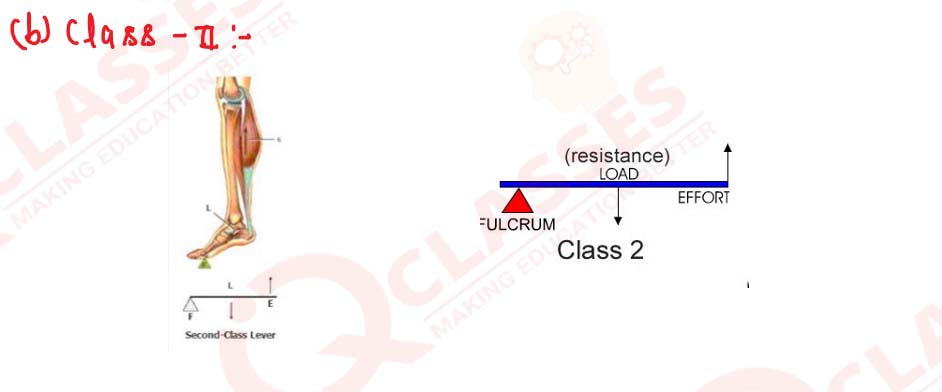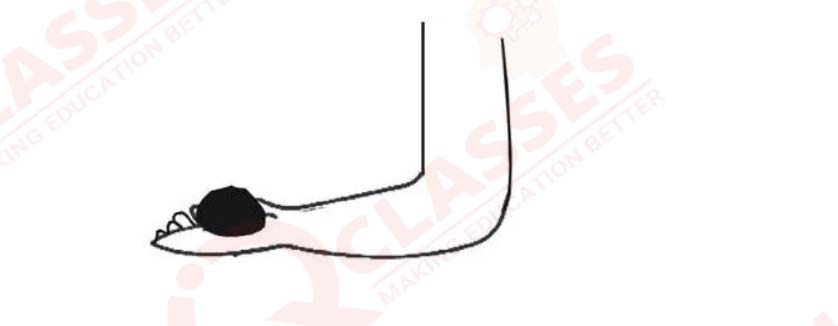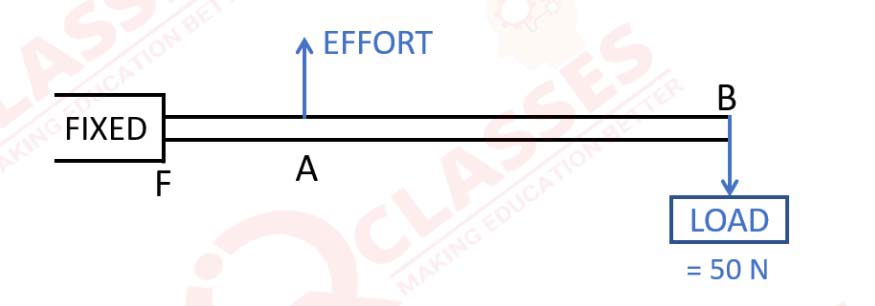Q1
(a) What do you understand by a simple machine?
(b) State the principle of an ideal machine
solutions

(b) State the principle of an ideal machine
solutions


Q2
State four ways in which machines are useful to us?
solutions
solutions

Q3
Name a machine for each of the following use —
(a) to multiply the force,
(b) to change the point of application of force,
(c) to change the direction of force,
(d) to obtain the gain in speed.
solutions

(a) to multiply the force,
(b) to change the point of application of force,
(c) to change the direction of force,
(d) to obtain the gain in speed.
solutions


Q4
What is the purpose of a jack in lifting a car by it?
solutions
solutions

Q5
What do you understand by an ideal machine? How does it differ from a practical machine?
solutions

solutions


Q6
Explain the term mechanical advantage. State its unit.
solutions
solutions

Q7
Define the term velocity ratio. State its unit.
solutions
solutions

Q8
How is mechanical advantage related to the velocity ratio for
(i) an ideal machine,
(ii) a practical machine?
solutions
(i) an ideal machine,
(ii) a practical machine?
solutions

Q9
Define the term efficiency of a machine. Give two reasons for a machine not to be 100% efficient?
solutions
solutions

Q10
When does a machine act as
(a) a force multiplier
(b) a speed multiplier?
Can a machine act as a force multiplier and speed multiplier simultaneously?
solutions

(a) a force multiplier
(b) a speed multiplier?
Can a machine act as a force multiplier and speed multiplier simultaneously?
solutions


Q11
A machine works as a
(i) force multiplier,
(ii) speed multiplier.
In each case state whether the velocity ratio is more than or less than 1.
solutions
(i) force multiplier,
(ii) speed multiplier.
In each case state whether the velocity ratio is more than or less than 1.
solutions

Q12
(a) State the relationship between mechanical advantage, velocity ratio and efficiency.
(b) Name the term that will not change for a machine of a given design.
solutions
(b) Name the term that will not change for a machine of a given design.
solutions

Q13
Derive a relationship between mechanical advantage, velocity ratio and efficiency of a machine.
solutions

solutions


Q14
How is mechanical advantage related to the velocity ratio for an actual machine? State whether the efficiency of such a machine is equal to 1, less than 1 or more than 1.
solutions
solutions

Q15
State one reason why mechanical advantage is less than the velocity ratio for an actual machine.
solutions
solutions

Q16
What is a lever? State its principle
solutions
solutions

Q17
Write down a relation expressing the mechanical advantage of a lever.
solutions
solutions

Q18
Name the three classes of levers and state how are they distinguished. Give two examples of each class.
solutions


solutions



Q19
Give one example each of a class I lever where the mechanical advantage is
(a) more than 1, and
(b) less than 1.
solutions
(a) more than 1, and
(b) less than 1.
solutions

Q20
What is the use of a lever if its mechanical advantage is
(a) more than 1,
(b) equal to 1, and
(c) less than 1?
solutions

(a) more than 1,
(b) equal to 1, and
(c) less than 1?
solutions


Q21
Both a pair of scissors and a pair of pliers belong to the same class of levers. Name the class of lever. Which one has the mechanical advantage less than 1?
solutions
solutions

Q22
Explain why scissors for cutting cloth may have blades longer than the handles, but shears for cutting metals have short blades and long handles.
solutions
solutions

Q23
Figure shows a uniform metre rule of weight W supported on a fulcrum at the 60 cm mark by applying the effort E at the 90 cm mark.

(a) State with reasons whether the weight W of the rule is greater than, less than or equal to the effort E.
(b) Find the mechanical advantage in an ideal case
solutions

(a) State with reasons whether the weight W of the rule is greater than, less than or equal to the effort E.
(b) Find the mechanical advantage in an ideal case
solutions

Q24
Which type of lever has a mechanical advantage always more than 1? Give reason with one example. What change can be made in this lever to increase its mechanical advantage?
solutions
solutions

Q25
Draw a diagram of a lever which is always used as a force multiplier. How is the effort arm related to the load arm in such a lever?
solutions
solutions

Q26
Explain why the mechanical advantage of a class II type of lever is always more than 1.
solutions
solutions

Q27
Draw a labelled diagram of a Class II lever. Give one example of such a lever.
solutions
solutions

Q28
Figure shows a lemon crusher.

(a) In the diagram, mark the position of the directions of load L and effort E.
(b) Name the class of lever.
solutions

(a) In the diagram, mark the position of the directions of load L and effort E.
(b) Name the class of lever.
solutions

Q29
The diagram below shows a rod lifting a stone.

(a) Mark position of fulcrum F and draw arrows to show the directions of load L and effort E.
(b) What class of lever is the rod?
(c) Give one more example of the same class of lever stated in part (b).
solutions

(a) Mark position of fulcrum F and draw arrows to show the directions of load L and effort E.
(b) What class of lever is the rod?
(c) Give one more example of the same class of lever stated in part (b).
solutions

Q30
State the kind of lever which always has the mechanical advantage less than 1. Draw a labelled diagram of such a lever.
solutions
solutions

Q31
Explain why the mechanical advantage of the class III lever is always less than 1.
solutions
solutions

Q32
Classes III levers have mechanical advantage less than 1. Why are they then used?
solutions
solutions

Q33
Draw a labelled sketch of a class III lever. Give one example of this kind of lever.
solutions
solutions

Q34
State the class of levers and the relative positions of load (L), effort (E) and fulcrum (F) in
(a) a bottle opener, and
(b) sugar tongs.
solutions
(a) a bottle opener, and
(b) sugar tongs.
solutions

Q35
Draw diagrams to illustrate the position of fulcrum, load and effort, in each of the following:
(a) A seesaw
(b) A common balance
(c) A nutcracker
(d) Forceps
solutions

(a) A seesaw
(b) A common balance
(c) A nutcracker
(d) Forceps
solutions


Q36
Classify the following into levers as class I, class II or class III:
(a) A door
(b) A catapult
(c) Claw hammer
(d) A wheel barrow
(e) A fishing rod
(f) Sugar tongs
solutions
(a) A door
(b) A catapult
(c) Claw hammer
(d) A wheel barrow
(e) A fishing rod
(f) Sugar tongs
solutions

Q37
What type of lever is formed by the human body while
(a) raising a load on the palm, and
(b) raising the weight of body on toes?
solutions

(a) raising a load on the palm, and
(b) raising the weight of body on toes?
solutions


Q38
Indicate the positions of load L, effort E and fulcrum F in the forearm shown below. Name the class of lever.

solutions

solutions

Q39
Give an example of each class of lever in a human body.
solutions

solutions


Q40
Complete the following sentences:
(a) Mechanical advantage = ...... × velocity ratio
(b) In class II lever, effort arm is ...... than the load arm.
(c) A pair of scissors is a ...... multiplier.
solutions
(a) Mechanical advantage = ...... × velocity ratio
(b) In class II lever, effort arm is ...... than the load arm.
(c) A pair of scissors is a ...... multiplier.
solutions

Multiple Choice type Questions :
Q1
Mechanical advantage (M.A.), load (L) and effort (E) are related as:
1. M.A. = L x E
2. M.A. x E = L
3. E = M.A. x L
4. None of these
solutions
1. M.A. = L x E
2. M.A. x E = L
3. E = M.A. x L
4. None of these
solutions

Q2
The correct relationship between the mechanical advantage (M.A.), velocity ratio (V.R.) and efficiency (η) is:
1. M.A. = η x V.R.
2. V.R. = η x M.A.
3. η = M.A. x V.R.
4. None of these
solutions
1. M.A. = η x V.R.
2. V.R. = η x M.A.
3. η = M.A. x V.R.
4. None of these
solutions

Q3
Select the incorrect statement:
1. A machine always has efficiency less than 100%.
2. The mechanical advantage of a machine can be less than 1.
3. A machine can be used as a speed multiplier.
4. A machine can have mechanical advantage greater than the velocity ratio.
solutions
1. A machine always has efficiency less than 100%.
2. The mechanical advantage of a machine can be less than 1.
3. A machine can be used as a speed multiplier.
4. A machine can have mechanical advantage greater than the velocity ratio.
solutions

Q4
The lever for which mechanical advantage is less than 1 has:
1. fulcrum at the mid-point between load and effort.
2. load between effort and fulcrum.
3. effort between fulcrum and load.
4. load and effort acting at the same point.
solutions
1. fulcrum at the mid-point between load and effort.
2. load between effort and fulcrum.
3. effort between fulcrum and load.
4. load and effort acting at the same point.
solutions

Q5
Class II levers are designed to have:
1. M.A. = V.R.
2. M.A. > V.R.
3. M.A. > 1
4. M.A. < 1
solutions
1. M.A. = V.R.
2. M.A. > V.R.
3. M.A. > 1
4. M.A. < 1
solutions

Numericals
Q1
A crowbar of length 120 cm has its fulcrum situated at a distance of 20 cm from the load. Calculate the mechanical advantage of the crowbar.
solutions
solutions

Q2
A pair of scissors has its blades 15 cm long, while its handles are 7.5 cm long. What is its mechanical advantage?
solutions
solutions

Q3
A force of 5kgf is required to cut a metal sheet. A pair of shears used for cutting the metal sheet has its blades 5 cm long, while its handles are 10 cm long. What effort is needed to cut the sheet?
solutions
solutions

Q4
The diagram below shows a lever in use.

(a) To which class of lever does it belong?
(b) If AB =1 m, AF= 0.4 m, find its mechanical advantage.
(c) Calculate the value of E.
solutions

(a) To which class of lever does it belong?
(b) If AB =1 m, AF= 0.4 m, find its mechanical advantage.
(c) Calculate the value of E.
solutions

Q5
A man uses a crowbar of length 1.5 m to raise a load of 75 kgf by putting a sharp edge below the bar at a distance 1 m from his hand.
(a) Draw a diagram of the arrangement showing the fulcrum (F), load (L) and effort (E) with their directions.
(b) State the kind of lever.
(c) Calculate — (i) load arm, (ii) effort arm, (iii) mechanical advantage, and (iv) the effort needed.
solutions
(a) Draw a diagram of the arrangement showing the fulcrum (F), load (L) and effort (E) with their directions.
(b) State the kind of lever.
(c) Calculate — (i) load arm, (ii) effort arm, (iii) mechanical advantage, and (iv) the effort needed.
solutions

Q6
A pair of scissors is used to cut a piece of cloth by keeping it at a distance of 8.0 cm from its rivet and applying an effort of 10 kgf by fingers at a distance 2.0 cm from the rivet.
(a) Find: (i) the mechanical advantage of scissors and (ii) the load offered by the cloth.
(b) How does the pair of scissors act - as a force multiplier or as a speed multiplier?
solutions
(a) Find: (i) the mechanical advantage of scissors and (ii) the load offered by the cloth.
(b) How does the pair of scissors act - as a force multiplier or as a speed multiplier?
solutions

Q7
A 4 m long rod of negligible weight is supported at a point 125 cm from its one end and a load of 18 kgf is suspended at a point 60 cm from the support on the shorter arm.
(a) If a weight W is placed at a distance of 250 cm from the support on the longer arm to balance the rod, find W.
(b) If a weight 5 kgf is kept to balance the rod, find its position.
(c) To which class of lever does it belong?
solutions

(a) If a weight W is placed at a distance of 250 cm from the support on the longer arm to balance the rod, find W.
(b) If a weight 5 kgf is kept to balance the rod, find its position.
(c) To which class of lever does it belong?
solutions


Q8
A lever of length 9 cm has its load arm 5 cm long and the effort arm is 9 cm long.
(a) To which class does it belong?
(b) Draw diagram of the lever showing the position of fulcrum F and directions of both the load L and effort E.
(c) What is the mechanical advantage and velocity ratio if the efficiency is 100%?
(d) What will be the mechanical advantage and velocity ratio if the efficiency becomes 50%?
solutions
(a) To which class does it belong?
(b) Draw diagram of the lever showing the position of fulcrum F and directions of both the load L and effort E.
(c) What is the mechanical advantage and velocity ratio if the efficiency is 100%?
(d) What will be the mechanical advantage and velocity ratio if the efficiency becomes 50%?
solutions

Q9
The diagram below shows a lever in use.

(a) To which class of lever does it belong?
(b) Without changing the dimensions of the lever, if the load is shifted towards the fulcrum what happens to the mechanical advantage of the lever?
solutions

(a) To which class of lever does it belong?
(b) Without changing the dimensions of the lever, if the load is shifted towards the fulcrum what happens to the mechanical advantage of the lever?
solutions

Q10
The figure below shows a wheel barrow of mass 15 kg carrying a load of 30 kgf with its centre of gravity at A. The points B and C are the centre of wheel and tip of the handle such that the horizontal distance AB = 20 cm and AC = 40 cm.

Find:
(a) the load arm,
(b) the effort arm,
(c) the mechanical advantage, and
(d) the minimum effort required to keep the leg just off the ground.
solutions

Find:
(a) the load arm,
(b) the effort arm,
(c) the mechanical advantage, and
(d) the minimum effort required to keep the leg just off the ground.
solutions

Q11
The diagram below shows the use of a lever.

(a) State the principle of moments as applied to the above lever.
(b) To which class of lever does it belong? Give an example of this class of lever.
(c) If FA = 10 cm, AB = 490 cm,
calculate:
(i) the mechanical advantage, and
(ii) the minimum effort required to lift the load (= 50N).
solutions


(a) State the principle of moments as applied to the above lever.
(b) To which class of lever does it belong? Give an example of this class of lever.
(c) If FA = 10 cm, AB = 490 cm,
calculate:
(i) the mechanical advantage, and
(ii) the minimum effort required to lift the load (= 50N).
solutions


Q12
A fire tongs has its arms 20 cm long. It is used to lift a coal of weight 1.5 kgf by applying an effort at a distance 15 cm from the fulcrum.
Find:
(i) the mechanical advantage of fire tongs and
(ii) the effort needed.
solutions
Find:
(i) the mechanical advantage of fire tongs and
(ii) the effort needed.
solutions
